Chinese New Year’s Eve: 过年
The end of the year is drawing near and we all gear up to celebrate New Year’s Eve soon. As a result, let me tell you more about what is behind this transition in Chinese Culture. How is celebrated Chinese New Year’s Eve?
In Nobody Knows, one of a Chinese webtoon I translated, some characters are 年 (Nian or 年兽 nianshou: Year monster), or “years”. You got that right, years indeed. They are neither gods, nor humans but demons that take care of evil demons, a bit like in The Witcher if you will – for those of you who know the video game or now, the TV series.
What is interesting about the idea of year being a monster is that we overcome the year, so to speak. In Chinese, the same applies. Chinese people overcome (or pass over, 过) the year (年).
Thus, I have to tell you a nice Chinese tale to illustrate why such words might be used.
And what would be a good story without a good storyteller? For this one, I asked a professional storyteller to help me narrate the full story. So allow me to introduce Mr. Wile E. Coyote.
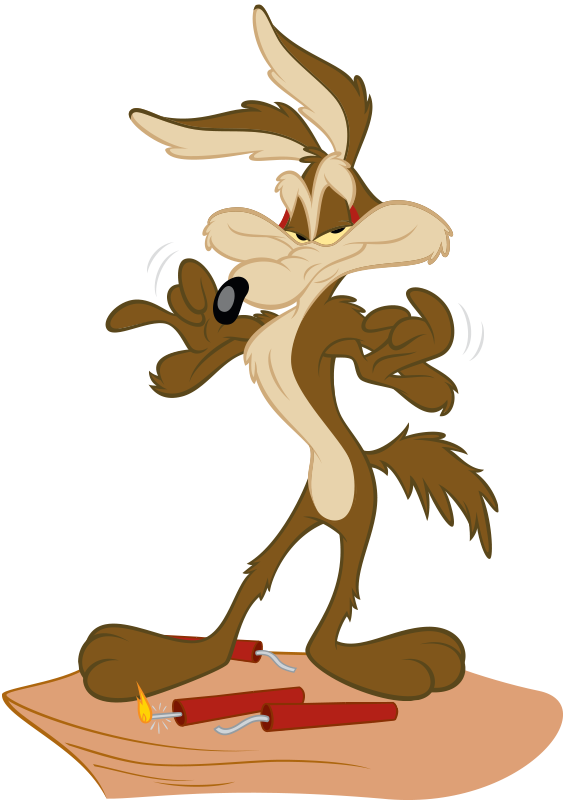
HERE COMES THE TALE
Once upon a time in a Chinese village – it doesn’t always occur in Hollywood or in deserts which is full of Road Runners – there was a monster called nian (年), which terrorized everyone on Chinese New Year’s Eve. This monster had a long head and sharp horns. It was usually also depicted with flat-face lion with a dog’s body and was said to remain hidden all year round. As a matter of fact, it only showed up on that special day in order to eat people and livestocks. Not the nicest way of getting yourself accepted by your neighbours…
As a consequence, people started becoming anxious about New Year’s Eve and most used to flee to the mountains to escape the monster at the beginning of each year. So, to sum it up, for Chinese New Year’s Eve, people were a bit like this:

Anyway, time went by and an old man with white hair – that’s important – visited the village. That man refused to hide in the mountains for New Year’s Eve and decided to spend the night there…
When the villagers came back, they were taken aback because they realised that the old man had managed to scare the monster away.
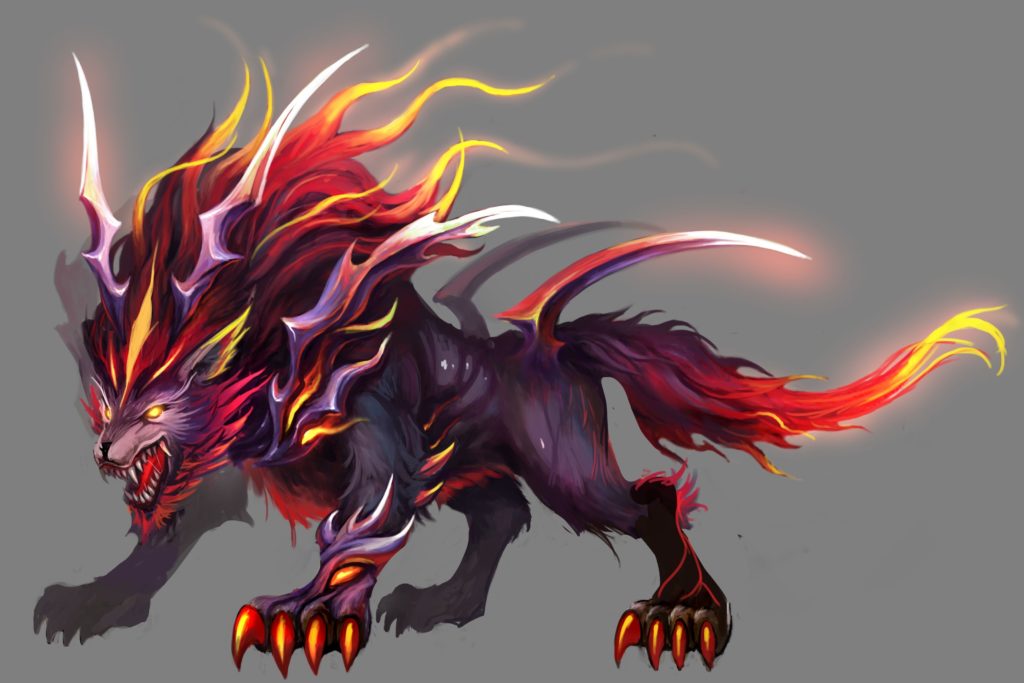
All the villagers were gobsmacked! Their village had suffered no damage and the old man was alive and kicking! The thing is he had pasted red papers on the doors, burnt bamboos to make loud cracking sounds, lit candles inside the houses and was wearing red clothes.
The old man let them know that the nian monster was afraid of noise, fire and the red colour.
As a consequence, they decided to act like the old man on New Year’s Eve and followed suit every following year.
According to the Chinese authorities, the nian monster (年兽) was, allegedly, nowhere to be found ever since and the villagers lived happily ever after…
However, the only problem now is that people tend to eat a bit much for New Year’s Eve and I, for one, often regret it, as you can see below.

Well, that is about it, folks. I hope you enjoyed my tale.
Personally, one of my New Year’s resolution is to run a bit more – with Road Runner – to lose that weight now… Wish me luck and all the best !
Cheers!
THE END

Thank you my dear Coyote! A true professional storyteller, indeed…
If, like our dear friend Mr Coyote, you eat too much during the holidays, don’t forget to take a good old lemon juice. It helps digest quite a bit…
Anyway, let’s get back to the topic at hand!
It’s important to bear in mind there are many different versions to this story…
Nonetheless, what is interesting with the aforementioned story is that what may be seen as a monster can also be seen as a metaphor. We might want to let go of our past demons, start afresh or turn over a new leaf.
The first day of the lunar year is fairly important in Chinese culture because people welcome the Godly spirits to their homes. As a rule of thumb, people should clean their houses before Chinese New Year’s Eve to ward off plague spirits and don’t use any broom or anything to clean on the first day.
They should wear new (and red) clothes and should not take any shower – or wash their hair – either because that would take all the new luck away. One is advised to open the windows and the doors to get some fresh air, let the previous year go, welcome the new year, relax and let in the Godly spirits. That day is supposed to reflect what will happen in the new year, so why not relax, huh?
Whether we believe in such things or not, it is always interesting to reflect on how customs are important and affect behaviours. Some local legends attribute the Chinese lion dance (舞狮) to the legend of the nian. There are so many other aspects and things I haven’t mentioned about Chinese New Year like the red letters, the dumplings and so forth, but I will leave it at that for the time being.
In addition, I’d like to point out that in Western countries, we share quite a lot of similarities with Chinese customs. Indeed, in France, we are also advised to wear red clothes in order to have good luck for the year to come. Besides, we – and the whole world – also enjoy fireworks celebrations.
QUESTIONS
- Would that celebration truly be linked to the old Chinese myth ?
- Would that be a way of letting go of the past and chasing a potential year monster ?
- What do you make of it ?
Please feel free to let me know !
I shall conclude by saying the year 2020 has been quite peculiar to say the least…
We may all want to turn the page and move forward, hoping things are about to look up.
So let me wish you all a Happy New Year and all the best for the year 2021 !
Peace and stay safe!
I will be back…

Noël, étymologie et solstice
Selon de nombreuses sources, le mot « Noël » viendrait du terme latin « Natalis dies ».
Cela signifierait « le jour de la naissance ».
Au niveau de l’étymologie du mot « Noël », on peut s’apercevoir que ce terme ressemble fortement aux termes équivalents dans les langues romanes tels que natale, nadal ou nadau en occitan, ou encore nadal en provençal. Après avoir fait disparaître le dies ainsi que le [i] et le [s] de Natalis, la lénition – ou adoucissement – de la consonne intervocalique [t] aurait donc donné nadal, puis son amuïssement naal et le terme se serait finalement devenu le terme « Noël » que nous connaissons. En effet, le mot Noël serait attesté dès le 12e siècle. On prétend que c’est l’accent de langue d’oïl qui transforma les [aa] en [oë], mais cela reste à confirmer.
Au-delà du débat de son origine chrétienne représentant la naissance du Christ (on s’en rend compte très clairement en anglais avec le terme « Christmas(s) », soit la « messe du Christ »), le solstice d’hiver était célébré par de nombreuses cultures de par le monde – telles que les cultures celtique et chinoise. On fêtait « le retour du soleil » et de la lumière – d’un point de vue physique et philosophique – dans l’ordre cosmique des choses.
Même si les mois de Janvier, Février et de Mars sont les plus froids. cela reste cependant logique si le soleil commence à « amorcer son retour » dans l’hémisphère nord – car il se produit l’inverse dans l’hémisphère Sud. C’est donc à partir de ce moment que les jours se rallongent en France.

Peu de gens savent que chez les celtiques, le sapin représente la fécondité. Il est capable de faire face à la noirceur et au froid de l’hiver. Il incarne le symbole de la puissance de la vie sur la mort et pourrait à cet égard avoir même un rôle protecteur. Le fait d’aller acheter un sapin n’est donc pas innocent et n’aurait peut-être aucun lien avec la fête Chrétienne… Ce qui est sûr c’est que l’utilisation d’un arbre à feuilles persistante symboliserait la vie éternelle pour de nombreuses cultures (en Égypte antique ou Chine notamment).
De nombreuses théories expliquent également le fait de décorer et d’accrocher des boules rouges au sapin, parmi lesquelles une prétendant que les Chrétiens souhaitaient symboliser des pommes pour représenter le fruit défendu. Il est cependant difficile de connaître la raison exacte. Le fait de briller dans l’obscurité, avec la bonne étoile guidant vers le sommet – au sens proche comme au figuré – pour également avoir un sens bien plus profond qu’il n’y parait.

Sur ce, comme le Père Noël est sur son PC, probablement en train de jouer à Candy Crush après avoir reçu votre email pour votre liste de cadeau, je vous laisse pour cette année car je m’apprête à me préparer pour les fêtes également. N’hésitez pas à m’en dire plus si vous connaissez l’origine du sapin ou les rites et coutumes de Noël. Ne mangez pas trop de chocolat (pas comme le goinfre ci-dessous). En ces temps étranges, la santé importe grandement…

Bonnes fêtes de fin d’année à toutes et à tous ! Et Joyeux Noël ! Ho ho ho !
😉
The more you know…
As a professional translator, I do a lot of research in various fields. It happens quite a lot actually, and thanks to that, I may be tempted to believe that my knowledge is ever-growing since I know more and more. And it is true up to a point.
Sometimes I learn new idioms or I improve my ability to perceive new nuances or notions, and I succeed in grasping all of their intricacies, and some others – especially when I think I know them well – life comes knocking on my door to prove me wrong.
This sort of situation can be quite humbling but it always proves itself very useful and rewarding when we show a bit of humility. I personally think we can learn a great deal from such situations.
After all, who hasn’t been proven wrong at least once? Besides, bloopers happen but the way we react to them can make all the difference!
So, in our quest to knowledge, I think there comes a time when we can all relate to what Socrates said, in that “the only true wisdom is in knowing you know nothing”, or as Jeremy Clarkson puts it “The more you know, the more you know nothing”.
Indeed, learning is a never-ending process and despite the progress we make over the years, there is no limit to it.
Quite humbling in itself, isn’t it? 😉
Feel free to comment if you have stories you would like to share.
Desiderata by Max Erhman
As Christmas closes in, I found an old poem by Max Erhman that dates from 1927. I wanted to share it with you under such a gloomy economic context. I also added a French translation right below the English one for those of you who only speak French. This prose poem is called “Desiderata”.
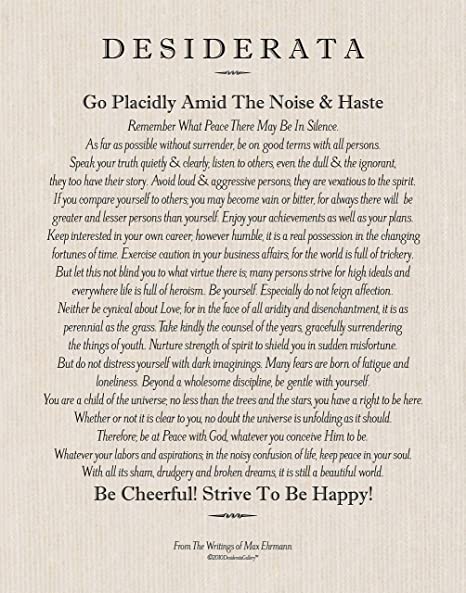
ENGLISH VERSION
Go placidly amid the noise and the haste, and remember what peace there may be in silence. As far as possible, without surrender, be on good terms with all persons.
Speak your truth quietly and clearly; and listen to others, even to the dull and the ignorant; they too have their story.
Avoid loud and aggressive persons; they are vexatious to the spirit. If you compare yourself with others, you may become vain or bitter, for always there will be greater and lesser persons than yourself.
Enjoy your achievements as well as your plans. Keep interested in your own career, however humble; it is a real possession in the changing fortunes of time.
Exercise caution in your business affairs, for the world is full of trickery. But let this not blind you to what virtue there is; many persons strive for high ideals, and everywhere life is full of heroism.
Be yourself. Especially do not feign affection. Neither be cynical about love; for in the face of all aridity and disenchantment, it is as perennial as the grass.
Take kindly the counsel of the years, gracefully surrendering the things of youth.
Nurture strength of spirit to shield you in sudden misfortune. But do not distress yourself with dark imaginings. Many fears are born of fatigue and loneliness.
Beyond a wholesome discipline, be gentle with yourself. You are a child of the universe no less than the trees and the stars; you have a right to be here.
And whether or not it is clear to you, no doubt the universe is unfolding as it should. Therefore be at peace with God, whatever you conceive Him to be. And whatever your labors and aspirations, in the noisy confusion of life, keep peace in your soul. With all its sham, drudgery and broken dreams, it is still a beautiful world. Be cheerful. Strive to be happy.
FRENCH VERSION
Va paisiblement ton chemin à travers le bruit et la hâte et souviens-toi que le silence est paix. Autant que faire se peut et sans courber la tête, soit amis avec tes semblables.
Exprime ta vérité calmement et clairement ; écoute les autres, même les plus ennuyeux ou les plus ignorants. Eux aussi ont quelque chose à dire. Fuis l’homme à la voix haute et autoritaire ; il pêche contre l’esprit.
Ne te compare pas aux autres par crainte de devenir vain ou amer car toujours tu trouveras meilleur ou pire que toi. Jouis de tes succès mais aussi de tes plans. Aime ton travail aussi humble soit-il car c’est un bien réel dans un monde incertain. Sois sage en affaires car le monde est trompeur.
Mais n’ignore pas non plus que vertu il y a, que beaucoup d’hommes poursuivent un idéal et que l’héroïsme n’est pas chose si rare. Sois toi-même et surtout ne feins pas l’amitié : n’aborde pas non plus l’amour avec cynisme, car malgré les vicissitudes et les désenchantements, il est aussi vivace que l’herbe que tu foules. Incline-toi devant l’inévitable passage des ans laissant sans regret la jeunesse et ses plaisirs.
Sache que pour être fort tu dois te préparer, mais ne succombe pas aux craintes chimériques qu’engendrent souvent fatigue et solitude. En deçà d’une sage discipline, sois bon avec toi-même.
Tu es bien le fils de l’univers, tout comme les arbres et les étoiles, tu y as ta place. Quoique tu penses, il est clair que l’univers continue sa marche comme il se doit. Sois donc en paix avec Dieu, quel qu’il puisse être pour toi.
Et quelle que soit ta tache et tes aspirations dans le bruit et la confusion, garde ton âme en paix. Malgré les vilenies, les labeurs, les rêves déçus, la vie a encore sa beauté. Sois prudent. Essaie d’être heureux.
A great poem, that is. Let me know what think! And if you have suggestions for any other great poem, please feel free to let me know. I may post a lot more in the future.
L’ambition et son implication religieuse
Le monde est sans foi ni loi. Outre le contexte d’une civilisation cachant lâchement les lacunes et responsabilités de l’homme moderne, si un homme a de l’ambition et souhaite se faire respecter par son entourage ou sa bande puis en devenir le chef dans la nature sauvage qui l’entoure, il doit, dans la plupart des cas, en devenir le plus méchant et le moins scrupuleux. Il inspirera ainsi crainte et donc respect à sa troupe car par la même occasion, il leur offrira un sentiment de sécurité. Sentiment que tout groupe nécessite naturellement et qui pousse chacun à se réfugier dans un groupe, au delà de la volonté d’un partage synergique de valeurs ou encore de cultures communes. Je vais donc parler ici de l’ambition et de son implication religieuse.
Dans un monde dangereux, pourquoi supporter les individualités de chacun si ce n’est par un désir lâche d’obtenir ce sentiment primaire de sécurité ? Cependant, le monde divin est un monde spirituel et respectueux de la vie. Lorsque l’homme souhaite donc gravir les échelons sociaux de son groupe, il doit sacrifier par conséquent une partie de sa spiritualité au profit d’un caractère plus volontariste, nécessitant de mettre de coté de nombreuses qualités spirituelles telles que la charité, l’humilité ou la pitié – à moins qu’il garde en tête des desseins plus grands. Ces qualités servent à progresser dans le cheminement intellectuel et divin mais ne sont d’aucune utilité pratique lorsque l’homme souhaite s’élever dans le confort de la pyramide sociale et tomber dans un rapport plus matérialiste des choses. S’il doit défendre son groupe, il devra faire usage d’agressivité et de violence physique ou mentale. Si ce n’est point le cas, un groupe plus agressif conquerra le sien et son rôle de leader sera déchu. Il perdra alors tout ce dont pourquoi il aura travaillé.

Moins un homme a de limites morales, plus il aura de chances de vaincre ses opposants. La fin justifie les moyens et ni la cupidité ni l’envie, deux péchés capitaux, n’ont jamais manqué aux hommes trop volontaires ou possédant trop d’ambition. Comme on le dit si bien, le vainqueur n’est jamais que l’homme qui en veut le plus. Et ce genre d’homme aime vaincre.
L’ambition et le rôle du chef
Car voici le rôle d’un chef : vaincre pour son clan et être le plus fort. En étant le plus fort, cela lui permet d’assurer une certaine peur à ses ennemis de façon à instaurer dans son clan un sentiment de sécurité et de pérennité possible. Cette harmonie lui permettra d’asseoir son règne et de tuer dans l’œuf toute rébellion interne éventuelle. Le fait de se faire respecter hors de ses frontières lui permettra également de créer des contacts, des amitiés et des alliances avec d’autres chefs voisins, ce qui à son tour l’aidera à renforcer sa puissance interne et externe. Il pourra annexer les chefs voisins les plus faibles de façon politique et sans combattre et ses victoires martiales lui apporteront gloire et fierté pour son peuple.
Un bon roi doit également connaître ses limites de façon à ce que la volonté qui a fait son ascension ne soit pas synonyme de chute. Car une volonté et un orgueil trop grand ont souvent été cause de chute. Lorsqu’on s’intéresse à l’histoire, où l’on voit bien que l’avenir n’est qu’un long passé, on s’aperçoit que de nombreux rois sont tombés à cause de leurs folies des grandeurs.
L’expansion et la restriction sont toujours nécessaires pour qu’un homme et un peuple gravissent certaines étapes et se préservent dans leur environnement. Et telle une courbe sinusoïdale, chacun doit trouver le bon timing.

L’implication religieuse de l’ambition
Mais revenons à l’aspect religieux de l’homme. Hormis l’accomplissement de ses besoins naturels, le sentiment de sécurité est le sentiment de base recherché par l’homme. Et si l’homme souhaite le ressentir, il devra soit se conformer au groupe avec un chef préexistant qui lui confère d’emblée ce sentiment, soit se créer un groupe tout seul par la force même de sa hardiesse et de son agressivité. Dans le dernier cas, il perdra sa spiritualité au profit d’un matérialiste sécuritaire et de jeux politiques car il ne devra compter que sur lui-même s’il souhaite être le chef de son clan. Et ces jeux politiques entraineront nécessairement une baisse de droiture dans ses actes et ses propos.
C’est tout là le paradoxe apparent. Un chef de guerre n’a pas vocation à être un bon religieux. Nous voyons cependant, que malgré une dichotomie évidente, ces deux points ambivalents peuvent se rejoindre de temps à autre sans se confondre néanmoins. Il s’agit dans ce cas d’un roi ou chef éclairé qui, ayant sacrifié de sa personne et de son innocence lors de son ascension au trône, s’y préserve en instaurant un code moral, auquel lui même, le premier, acquiescera. Son code, pour la plupart des chefs éclairés, a pour but de mettre sur pied une pratique exemplaire de chacun conduisant à l’harmonie civile et naturelle, donc divine, de sa nation. Afin de regagner les vertus mises de coté lors de cette même ascension sociale et d’en faire profiter le plus grand nombre – ce qui est en soi-même un acte des plus vertueux – également un processus nécessaire. Le dilemme réside alors ensuite dans la sécurité de son règne et de la façon dont il peut le garder et l’asseoir afin d’étendre son message et en passant son autorité.
J’ai aussi à penser, qu’au delà de la nécessité d’être le plus méchant, l’homme le plus utile au groupe peut également devenir le chef. Cependant, si une fois reconnu chef par sa bande, il ne prouve aucune autorité ni aucune amélioration à l’état des choses passées, les mêmes qui l’auront mis à sa place de chef pourront aisément le défaire, et cela sans scrupule, de ses fonctions par de nombreuses méthodes, notamment celle de la force brute ou du complot. La foule, et cela fût maintes fois démontré par de nombreux auteurs tels que Gustave Lebon notamment, réagit à l’émotion et non à l’intellect. En cela, un chef doit savoir être dur et parfois cruel. Nécessité fait loi. Et le chef éclairé comprend la nécessité paradoxale de la violence – mentale ou physique – pour instaurer la non-violence et l’harmonie. Toute l’ambivalence de ce paradoxe tient dans l’équilibre infime de la spiritualité et du pouvoir. L’exercice de la religion et du pouvoir doit trouver un point d’équilibre et c’est par la codification qu’il est le plus efficace. Un code moral et civil est établit à ce dessein pour la population qui en a besoin.
Bref, peu font note de la responsabilité de l’exercice du pouvoir et cela quel qu’il soit. Chaque ascension personnelle est similaire à l’ascension sociale du roi que j’ai illustré car elle vise le même but : un confort et une sécurité matérielle. La différence tient seulement dans la puissance de l’ascension. Pour avoir bravé maints dangers en acceptant par ses actes de s’être assombri l’âme pour s’être glissé au sommet, un chef doit aussi s’y maintenir. Tant que l’homme roi ne saura freiner ses émotions et en sera esclave, cette volonté de maintien laissera presque toujours place à une ambition ou une volonté d’expansion qui forcera ainsi le morcellement de sa personne et de son royaume. Il aura tout perdu à vouloir tout avoir, car il n’aura pas jugé nécessaire ou bon de réfléchir aux conséquences et risques spirituels et moraux d’une telle ascension.

Comment trouver l’équilibre entre volonté de réussir et désir de paix ?
La phrase de Jésus « les premiers sont les derniers et les derniers sont les premiers » prend alors tout son sens. En souhaitant être le premier, on creuse petit à petit sa tombe et devient le dernier. On vise ce qui brille de façon éphémère à l’extérieur, alors que par nos actes arrivistes, nous salissons en nous ce qui brille de façon éternelle à l’intérieur. Si extérieurement, nous sommes derniers, cela ne signifie pas forcement que nous soyons les premiers intérieurement non plus. Mais à chercher à être le premier extérieurement, c’est à dire dans ce monde sans foi ni loi, où comme je l’ai démontré la force et les vices aident grandement pour arriver au sommet du matérialiste et du confort, nous finirons toujours par être les derniers et n’arriveront jamais à être en harmonie en interne et en externe.
Un homme qui ne sait pas restreindre son ambition, qu’il soit Roi ou non, finira toujours par chuter à cause du fait qu’il est esclave de sa volonté d’expansion, militaire, sociale, et même religieuse. Et peu importe le contexte. De même, plus l’homme a de responsabilités, plus ses conséquences dans le monde en seront catastrophiques pour autrui s’il ne maitrise pas sa volonté.

Alors sachons maitriser nos émotions et notre ambition et gravissons progressivement et en paix les échelons de notre réussite.
Que la paix intérieure vous guide. 😉
Do you speak zombie?
At a time when covid is still prevalent and most of us might be compelled to spend an unprecedented Christmas, as a linguist, one thought suddenly occured to me when I was translating a picture in which there was a zombie:
Should I use “Gwargh”, “Grrarl” or “Grahh”?
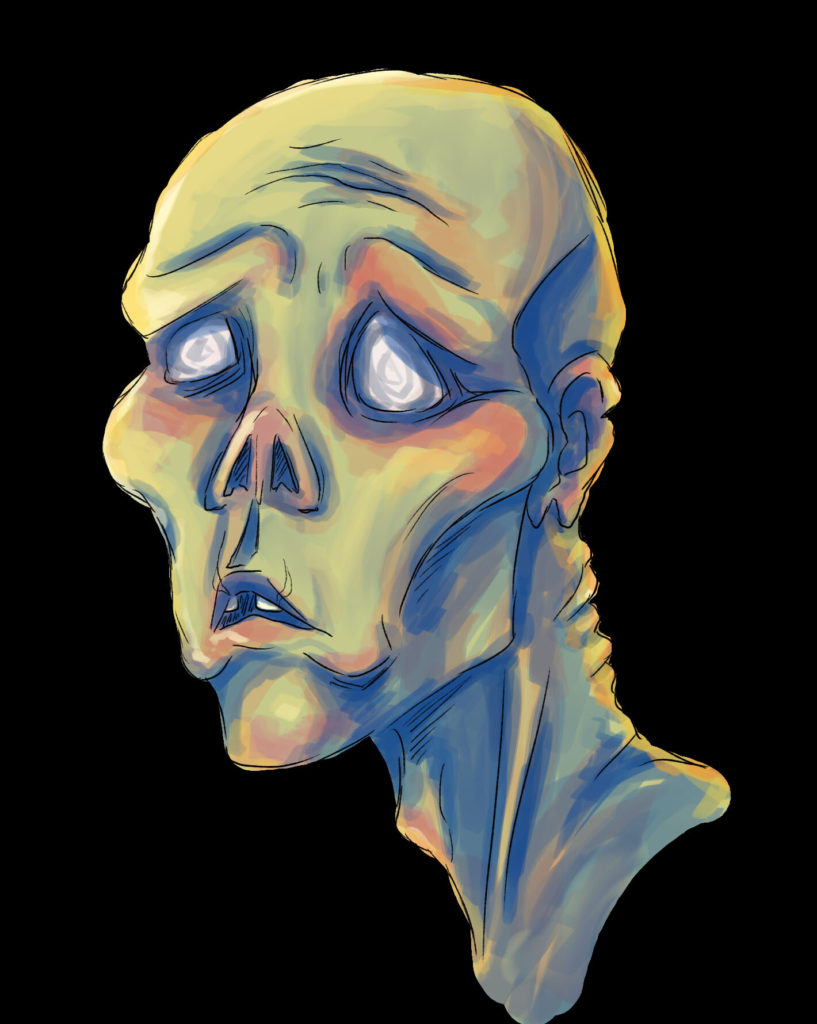
The idea might come across as far-fetched or even totally irrelevant in the run-up to Christmas but may nevertheless be food for thought, indeed – no pun intended here (zombie do not eat thoughts, they are more pragmatic. Well, so I have been told).
In the translation world, especially in the fields of comic books, mangas or webtoons, translators are bound to encounter onomatopoeia such as “Garrgh” or “Ghmph” among other things and may stop for a while and ponder over whether “Gwargh”, “Ghmph”, “Grrarl” or “Grahh” is more relevant in such a context.
Practical example
Let’s take an example: Mr. Zombie1 – we will call him Albert because he wears a tie – says to his fellow zombie friend, Ms. Zombie2 – her name is Elsa and Albert likes her eyes, but we’ll keep it at that – the following statement: “I am not sure, my dear, that these remaining humans whet my appetite. I don’t find the skinny one really yummy. Plus, he has got a big nose.” To which Elsa answers : “Neither do I. I am not even sure whether or not he has the covid-23. Well, I guess beggars can’t be choosers… Bon appetit”. Out of contempt and given the look of those panic-stricken humans cornered in the back of the room and located in front of him, Albert then ventures a “Grrarl !”.
So here is the big question: What impact would “Gwaak” have in the reader’s mind, instead of a good old “Grrarl” from the 90s? (90s expressions are timeless, if you ask me)
The role of translators
Kidding aside (or not really…), as a translator, this is a fundamental question. Indeed, most of our work is to transpose, create or reword native expressions into different cultures through the rewording we operate.
In addition, one can only wonder about the influence of such slight differences in onomatopoeia and taking time to choose the right word should not be considered as a nitpicking activity in the translation word, but as a thorough part of a continuous process of improvement in our understanding and grasp of the language we use.
Translators are wordsmiths, after all. And we enjoy creative freedom up to a point.
Not being completely familiar with zombies’ customs and slang for the time being, I, for one, need to do more research on zombie onomatopoeia. However, given that I have already done some on other monsters’ onomatopoeia – not to mention any name here – I might already have a leg up (or not, since Halloween was about 2 weeks ago ^^) . Thus, odds are my previous work will prove fruitful.
Last but not least, as our dear Albert ventured a “Grrarl” (or “Gwaak!”, who knows, mistakes happen), I would conclude here with a French onomatopoeia “Zwish!” depicting the rapidity with which I wrote this post (I zwish! lol).
😉
Treatise on Karma – 太上感應篇
The treatise on Karma – 太上感應篇 Taishang Ganying Pian – is a Taoist treatise that covers the retribution of thoughts, words, and deeds, and explains how karma works. It’s all about doing what’s good and right and turning away from evil.
I espacially like the first line that reads:
祸福无门,维人自召。善恶之报,如影随形。
A translation of it could be : “Fortune and misery do not happen at random. There are merely the consequences of a person’s actions. Whether they be good or evil, these actions are inseparable from their authors.” (or “follow everybody like a shadow” in Chinese. I also chose to point out this Chinese expression 如影随形 here because I like it. It clearly depicts how inseparable from the individuals such actions are considered. ^^)
Indeed, we all need a little reminder of Karmic laws (法/因果报应) from time to time…

To me, the Treatise on Karma – 太上感應篇 – is a must-read if you’re into taoism. If not, it is nevertheless an interesting read. From a Taoist perspective, what is written here is golden. Li Ying-Chang, who was a scholar who retired from civil administration to teach Taoism, is the person who has allegedly authored this. Nothing is for sure though.
I put some versions in English here, in French here and in Chinese here.
Enjoy ! 😉
Attention : absence of tension ?
The term “attention” derives from the latin “attentio”: put your mind to/focus on. Indeed, when we give something our attention, our mind pays attention to it.
It may even goes so far as to get us fixated on it and being caught up in a sort of tunnel vision. Our field of vision might indeed become narrower and as a result, we might pay no more attention to the things around us.

Despite its latin etymology, we may also ponder its hidden meaning, especially when studying the implication of the letter “A” in Sanskrit, which bears the meaning of “without”, “lack of”.
As a result, what if “Attention” were meant to imply “Without tension” ?
This way of seeing things correlates the lack of tension and our greater ability to perceive things around us.
A different sort of attention
This has often been pointed out in martial arts or in the Zen doctrine, for instance, where greater concentration may be a result of non-attachment and of us letting things go naturally, following the Dao or natural way, as such. In such a state, we may perceive things that are around us without losing focus on our rooting. Inner peace could be achieved more easily.
Indeed, Zen or other martial practices also stress the importance of being relaxed or 放松 before entering calmness – 入静。As a matter of fact, it is often advised to relax before practising Qigong so that the energy circulates smoothly.
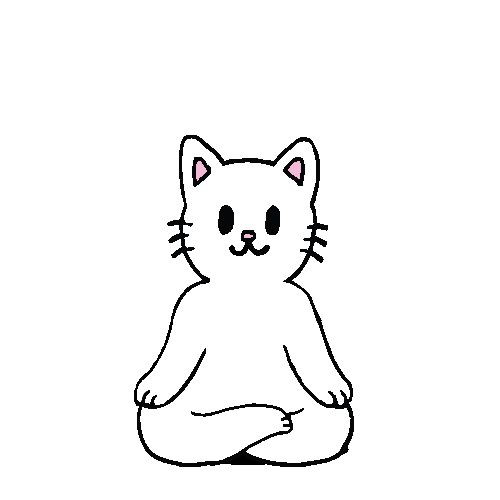
Therefore, would attention be synonymous with “absence of tension” ? Would calming down and reaching peace of mind have any effect on our perception ? I tend to believe so. Be attentive would thus be a quiet way of observing ourselves and what it is all around us more deeply.
That notion gives us quite a lot of food for thought…
Please feel free to comment this post ! 🙂
易筋经 Yijinjing, Classic of Muscles and Tendons
易筋经 Yijinjing – or Classic of Muscles and Tendons – is a series of exercises created with the aim of strengthening our muscles and tendons. In Chinese Yi means “change”, jin means “tendons and sinews” and Jing means “classic”. Hence, Yijinjing might be translated as the “Classic of tendons and muscles” – I let the “changing” aspect of “Yi” aside here. The benefits of a daily practice are plentiful and I am not going to enumerate them here but will only show you the different moves with a description below so as to help you put the theory into practice and grasp the meaning behind each exercise.
It goes like this picture below.
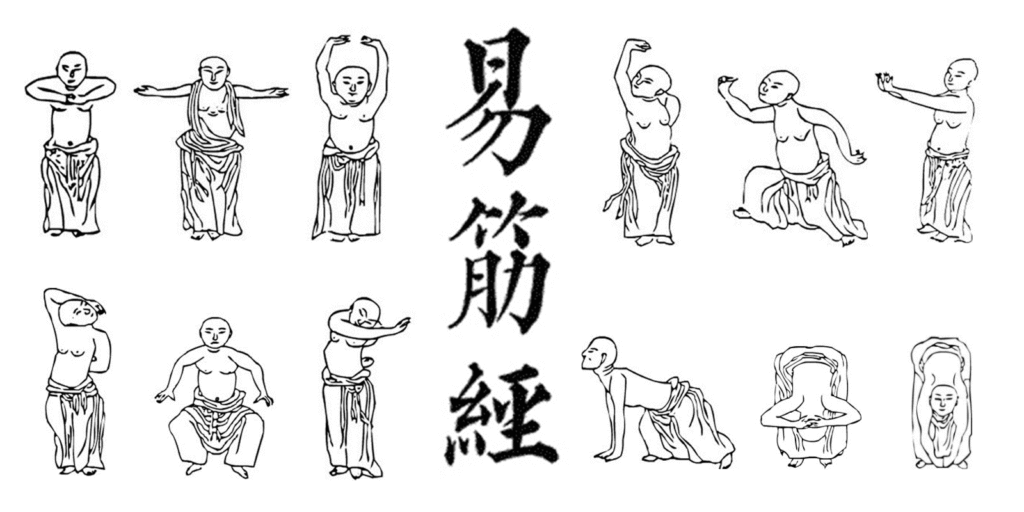
Here is a nice video from a Shaolin monk:
List of moves for the Yijinjing – 易筋经
韦驮献杵势Weituo xian chu shi: Weituo (Skanda) presents the pestle
This move is the first of the whole series. As a result, you should calm down, and adjust your breathing accordingly. It’s time you for you to relax and gear up mentally for the whole series. This moves help improve the nervous system and the bold circulation.
横担降魔杵势 hengdan jiangmo chu shi: The horizontality of the pestle gets rid of the demons
This move might also be known as 韦驮献杵第二式(Weituo xian chu 底er shi) which means it is the second form of Weituo presents the pestle. Depending of the forms, some introduce the first 3 moves under the same name. I haven’t done so here because it is quite subjective to me, but whatever floats your boat… I don’t think it’s very useful to be too prescriptive on that… Anyway, the move enhances the muscles of the shoulders and the arms and improves the mobility of the Qi.
掌托天门势 zhang tuo tian men shi: The palms of both hands hold up the skies
As previously said, that move might also be known as 韦驮献杵第三式(Weituo xian chu 底er shi) which means it is the third part of Weituo presents the pestle. This move aims at invigorating for the blood circulation and resembles the first move of the Baduanjin.
摘星换斗势zhai xing huan dou shi: Plucking a star on each side
The correct translation of such move should be “Plucking a start and spinning it around the North Star/Polaris (which is fixed)” but is a more famous as “Plucking a star on each side” so I kept it that way. I like that move. Moreover, the metaphor is truly poetic. Hence, you should gaze the center of your palm while spinning. It strengthens the waist and kidneys and prevents aging.
倒拽九牛尾势 daozhuai jiu niuwei shi: Pulling 9 cows by their tails
Turning the waist and shoulder stimulates various points and is good for the heart and the lungs. I noticed this move improves core strength.
出爪亮翅势 chu zhao liangchi shi: Showing one’s claws and revealing one’s wings
Make a circular move with your arms and push forward. Do it thrice and try to go a little bit further each time. It’s a great move for the lungs, considered as the mother of Qi.
九鬼拔马刀势 jiu gui ba ma dao shi: The nine ghosts draw their swords
Both sides are stretched and as a result, the spleen and stomach are massaged. Morever the kidneys are strengthened by such a move.
三盘落地势 san pan luodi shi: Sinking on the tree bodily zones
I would translate 落地 as landing down because the moves refers to a sort of landing or rather an exploration of the three layers or levels of the body. I found it would be a good equivalent to the Chinese term 落地. It’s quite a subjective translation though. As for its effects, it enables to strengthen the waist, the kidneys, the abdomen as well as the Qi of the dantian.
青龙探爪势 Qinglong tan zhao shi: The green Dragon displaying its his claws
Given the move, I would have translated it as “the green dragon putting his claws to good use” or “putting his claws to the test” ^^. Well, you get the picture… Very interesting move indeed, which is good for stretching, hence improves your flexibility, smooths the mind and has many benefits for the liver as well. I truly love doing it. It looks like you pick up something from the ground.
卧虎扑食势 wuHu pushi shi: The crouched tiger pounces on its prey
Get your claws out and pounce on an invisible prey! Grr !!! Then, keep with your claws fixed into the ground and lift your head gently. Remain in this position just a bit and go back to your original position without losing balance. There are many ways of getting back to the original position, like lifting one leg before the other (or some lift it very high, like a scorpion) but I won’t go into details about that here. As long as you keep your balance, you should be fine. According to what I read somewhere, the tilting backward of the body and the flexing of the chest and abdominal cavities help to dredge the Ren Mai meridian.
打躬击鼓势 dagong jigu shi: Bowing for salutation and beating the drums
Place both hands near the ears (you don’t need to touch them) and tilt forward slowly. While doing so, try to keep your legs and your back straight. You don’t need to go too low. Do as you see fit. If the move is well done, you may feel some sort of gentle drumbeats around your kidneys when bending. That’s a good name for such a move indeed. It increases the hearing capacity and reduce brain fatigue by refreshing it with good enery.
工尾势 gongwei shi: Swinging the tail
Finally, this last move enables the body to relax completely. The description of this move is quite explicit. Tilt foward once more and move your butt as if you had a tail that you wanted to move on both sides while following suit with your head (watching left or right, I mean). I find this move quite funny.
That’s about it ! Don’t forget to relax when practicing the Yijinjing! Enjoy and get your fill of good energy ! 😉
八段锦 Baduanjin – Eight Pieces of Brocade
For those of you who wouldn’t be familiar with Qigong, 八段锦 Baduanjin – the Eight Pieces of Brocade in Chinese – is one of the most well-known and practised form of Chinese qigong. The name of this form derives from a metaphor depicting how the eight moves of such a form characterize and wrap the body in a silken-like quality (the likes of a piece of brocade) through its energy.
Dating back as far as the Song dynasty, this series of movements comprises 8 exercises, each focusing on and benefiting a different area of the body – and undoubtedly its corresponding meridians.
It goes like this :
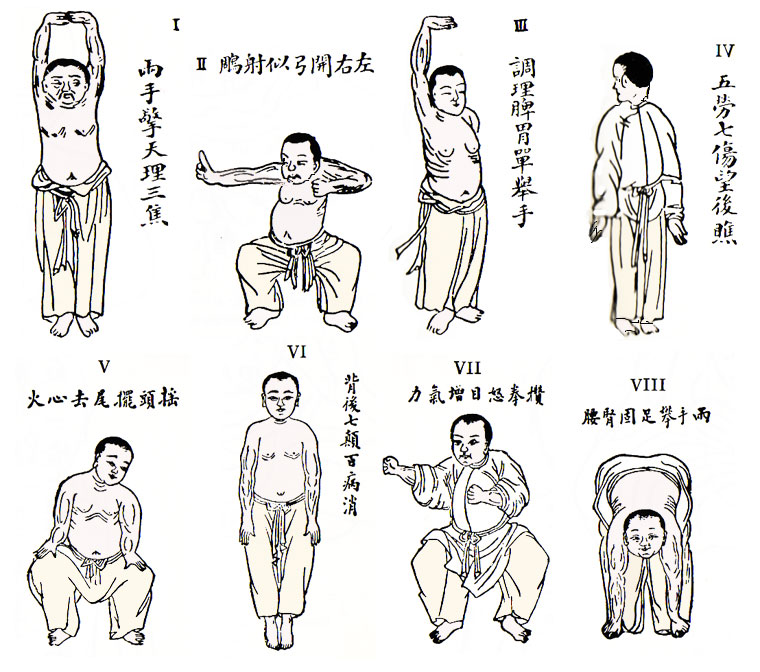
Here is a video of a shaolin version of it:
Description of the moves
1) 双手托天理三焦 (shuang shou tuo tian li sanjiao): Two Hands Hold up the Heavens
This move consists of an upward movement of the hands, from the center of the body to above the head, as if one were holding up the skies. It is said to stimulate the Triple Heater (三焦). Plus, it is quite commonplace to clean and prepare the triple heater before any other move is made indeed.
2) 左右开弓似射雕 (zuoyou kai gong si she diao): Drawing the Bow to Shoot the Hawk
While remaining in the position of the horse stance, also known as 马步 (mabu) in martial arts, the practionner acts as if he were drawing a bow and shooting in both directions (left and right). That move is supposedly good for the waist, the kidneys and the spleen.
3) 调理脾胃须单举 (tiaoli piwei xu dan ju): Separating Heaven and Earth
Strictly speaking, this move doesn’t mean “separating heaven and earth”. I kept it because it is poetic and quite commonplace to refer to it as “the separation of heaven and earth”. Indeed, both hands are separated and should remain horizontal. However, it means “taking care of/healing the spleen and the stomach just by lifting the hand”. I guess you figured what the benefits of such a move are by now, right ?
4) 五劳七伤向后瞧 (wulao qi shang xiang hou qiao): The wise owl gazes backward
This is a stretch of the neck to the left and the right in an alternating fashion. There is no mention of any owl in the Chinese description but I guess the move speaks for itself and resembles an owl that turns its head, hence the mention of the animal. It is said to prevent the ‘5 lesions and 7 injuries’ (五劳七伤), also known in TCM, [ which are said to be caused to the spleen by overeating, to the liver by rage, to the kidneys by lifting heavy weights and sitting too long on wet ground, to the lungs by wearing too little and taking cold food and drinks, to the heart by sorrow and anxiety, to the body by abrupt weather changes, and to the consciousness by immoderate fear]
5) 摇头摆尾去心火 (yao tou bai wei qu xin huo): Sway the Head and Shake the Tail
By rolling the head and shaking the tail, you will get rid of the fire (excessive heat) from your heart. In another horse stance, the practionner places the hands on thighs with the elbows facing out and twists to glance backwards on each side. This move is beneficial for the heart and the lungs.
6) 两手攀足固肾腰 (liangshou pan zu gu shen yao): Two Hands Hold the Feet to Strengthen the Kidneys and Waist
This involves a stretch upwards followed by a forward bend and a holding of the toes. The conduct of the the breath may help out on this one. Personally, it’s one of the moves I enjoy the most.
7) 攒拳怒目增气力 (zan quan numu zeng qili): Clench the Fists and Glare Fiercely
This resembles the second piece as you still have to remain in the horse stance (马步), and consists of a punching movement forward. This, which is the most external of the pieces, is aimed at increasing general vitality and muscular strength. Indeed, when closing your hands after the punch, take time to visualize the energy getting in through your palms.
8) 背后七颠百病消 (beihou qidian baibing xiao): Bouncing on your toes
This is a push upward from the toes with a small rocking motion on landing. The gentle shaking vibrations of this piece is said to “smooth out” the qi after practice of the preceding seven pieces or, in some systems, this is more specifically to follow Sway the Head and Shake the Tail. When you let yourself go and hit the floor, let it go smoothly ! Don’t make it hard and shock your body. You wanna stay quite flexible so the hit doesn’t stiffen you up or hurt you.
🙂 Well, that’s all folks ! You’re done !
Additional video
Don’t you worry if the video above is too martial or extreme for you. You can find plenty of other versions on Youtube. Here is another interesting one though, this time from a Wudang monk.
Have fun and enjoy your practice of 八段锦 Baduanjin – the Eight Pieces of Brocade!
May the Qi be with you… 😉